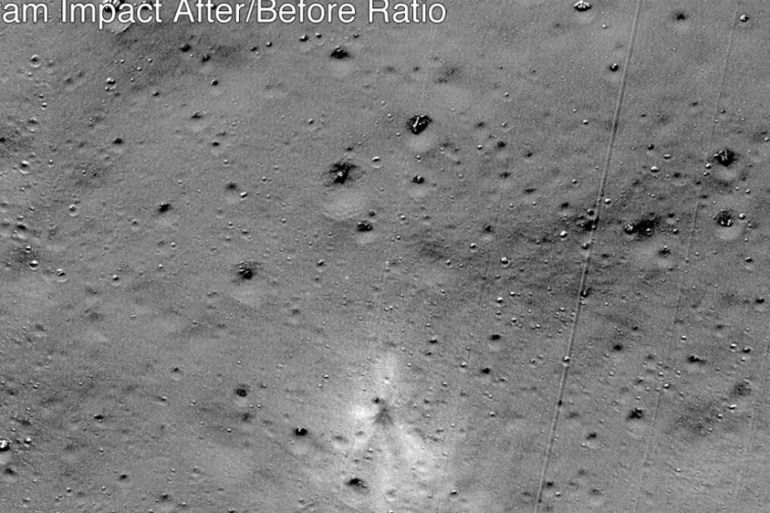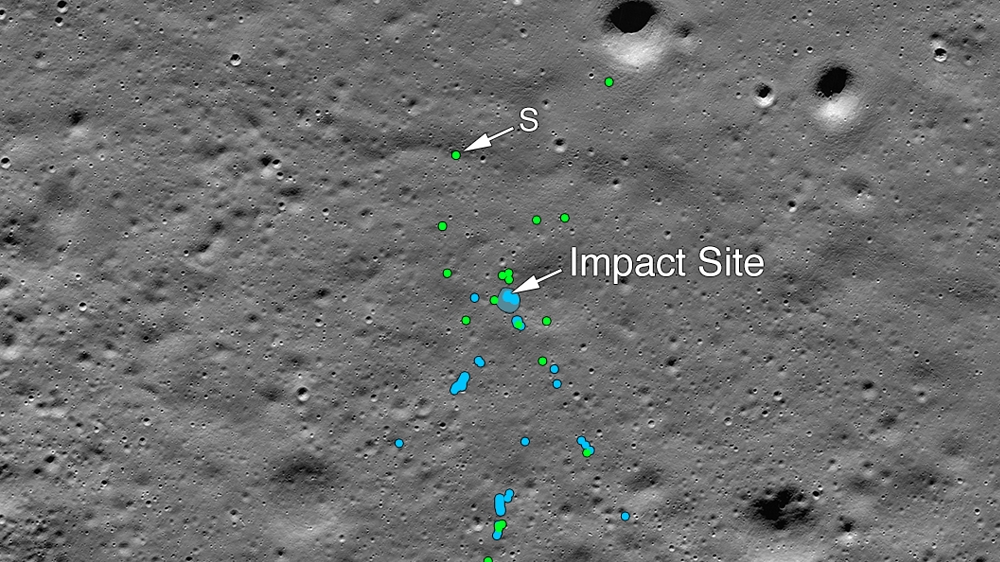NASA satellite finds crashed Indian Moon lander Vikram
US space agency released an image that showed site of spacecraft’s impact and associated debris field.

A NASA satellite orbiting the Moon has found India’s Vikram lander which crashed on the lunar surface in September, the United States space agency has said.
NASA made the announcement on Monday, releasing an image taken by its Lunar Reconnaissance Orbiter (LRO) that showed the site of the spacecraft’s impact (September 6 in India and September 7 in the US).
Keep reading
list of 3 itemsThe sun is setting on Vikram lander but not on Chandrayaan-2
India’s moon probe made hard landing, says NASA
A version of the picture was marked up to show the associated debris field, with parts scattered over almost two dozen locations spanning several kilometres.
In a statement, NASA said it released a mosaic image of the site on September 26 (but taken on September 17), inviting the public to compare it with images of the same area before the crash to find signs of the lander.
The first person to come up with a positive identification was Shanmuga “Shan” Subramanian, a 33-year-old IT professional from Chennai, who told AFP that NASA’s inability to find the lander on its own had sparked his interest.

“I had side-by-side comparison of those two images on two of my laptops… on one side there was the old image, and another side there was the new image released by NASA,” he said, adding he was helped by fellow Twitter and Reddit users.
“It was quite hard, but (I) spent some effort,” said the self-professed space nerd, finally announcing his discovery on Twitter on October 3.
NASA then performed additional searches in the area and officially announced the finding almost two months later.
“NASA has to be 100 percent sure before they can go public, and that’s the reason they waited to confirm it, and even I would have done the same,” said Subramanian.
‘A stepping stone to success’
“It was quite clear that Vikram had hard-landed on the lunar surface… That it failed so close to the lunar surface is a testament to the skill of the very young Chandrayaan 2 (Moon Vehicle 2) team,” said Pallava Bagla, author of Reaching for the Stars: India’s Journey to Moon, Mars and Beyond.
Space is indeed a risky business and not meant for the faint-hearted, acknowledging failure is a stepping stone to success.
“But that the Indian space agency took nearly two months to acknowledge the failure is an astonishing fact,” he told Al Jazeera.
“Space is indeed a risky business and not meant for the faint-hearted, acknowledging failure is a stepping stone to success.”
Blasting off in July, emerging Asian giant India had hoped with its Chandrayaan-2 mission to become just the fourth country after the US, Russia and regional rival China to make a successful Moon landing and the first on the lunar south pole.
The main spacecraft, which remains in orbit around the Moon, dropped the unmanned lander Vikram for a descent that would take five days, but the probe went silent just 2.1 kilometres (1.3 miles) above the surface.
Days after the failed landing, the Indian Space Research Organisation said it had located the lander but had not been able to establish communication.
Bilal Kuchay contributed to the article from New Delhi